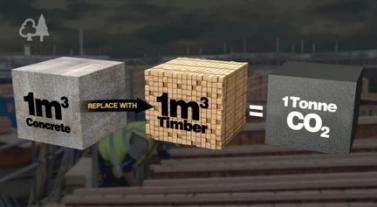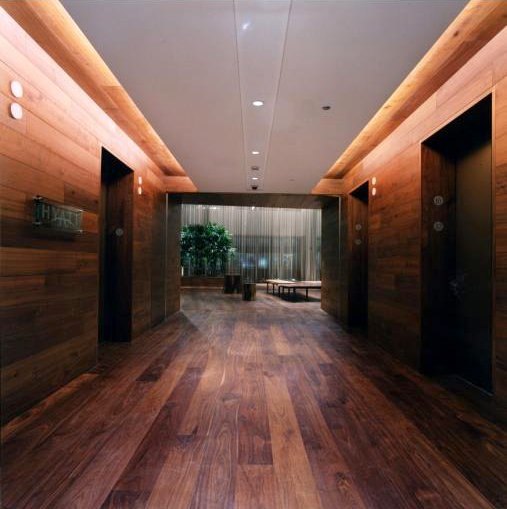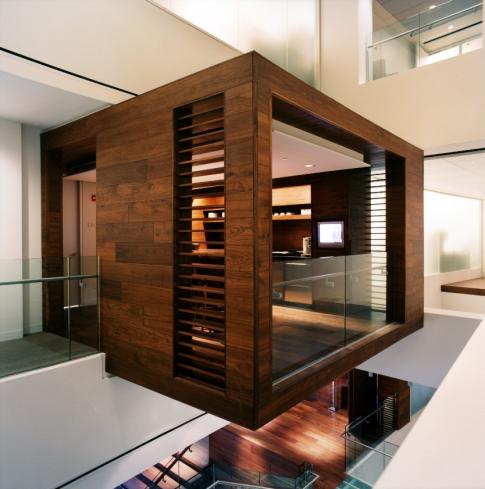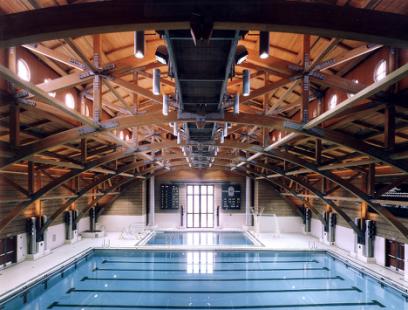A popular Chinese saying has been trending recently which roughly means “having lived half of your life, you may retain a youthful heart.” This phrase is very fitting for the director of SOM China, Silas Chiow. Despite working in the field for more than 30 years, Silas has a passion towards architectural concepts and environmental design that stands out from his usual quiet and gentle demeanor, just like a scholar who is delighted at the opportunity to share his passion with someone who expresses interest. If you are lucky enough to hear Silas share his love for wood, then you will also begin to understand the irreplaceable beauty of wood.
Wood Brings Nature into the City
The completion of a building requires many materials, but Silas makes his enthusiasm for wood obvious. “I love nature. Although stone is also a natural material, it lacks the warmth and softness of wood. Wood shares a closer relationship with the people,” says Silas. On top of that, wood is effective for energy conservation and emission reduction.
Founded in 1936, Skidmore, Owings and Merrill LLP (SOM) is a world-class design firm. Many globally-recognized high-rise landmarks were designed by SOM, including the Shanghai Jinmao Tower, China’s first skyscraper, and the Burj Khalifa, the tallest building in the world, which stands 828m high in Dubai.
Skyscrapers are undoubtedly a symbol of the era, vertical development caused by overcrowding, the confidence to conquer the unknown for the sake of development and arrogant ambition which disregards everything else. All of which have contributed to taller and taller buildings and a continued journey towards closing the distance with the sky.
The skyscrapers’ less glamorous side is its representation as the cost of urbanization, pollution and excessive energy consumption. The Ministry of Housing and Urban-Rural Development of the People’s Republic of China recorded that at the end of the year 2000, architecture had accounted for 27.6 percent of the total annual energy consumption in China’s society and the increased energy use in architecture had contributed to a quarter of the country’s greenhouse gas emissions. “The construction and use of buildings directly and indirectly account for at least half of society’s total energy consumption,” said Silas.

In contrast, wood is characterized as pure, less imposing and environmentally friendly. It’s because of these characteristics that wood is the most capable of counteracting the negative aspects brought on by the development of flamboyant skyscrapers. According to the American Hardwood Export Council (AHEC), when 1 cubic meter of concrete is replaced by 1 cubic meter of wood, carbon dioxide emissions can be reduced by 1 ton.
One of the reasons for this is that trees absorb a lot of carbon dioxide during its growth. When the tree is harvested or used, the carbon dioxide is permanently stored within the wood product, acting as a carbon sink. Another reason is that energy required for the processing of wood into its final product is less than almost all other building materials, making it the benchmark for materials in energy efficiency and emission reduction.
The Fascinating Wooden Box
Although timber use is gaining traction amongst city inhabitants, descriptions of wood are bound to adjectives like simple and natural, as though it was entirely separate from the grand metropolises. With its profound cultural heritage, SOM has helped timber successfully integrate into Chicago, the third largest city in the United States.
The global headquarters of the Hyatt Group is one of the many high-rise buildings in Chicago and its interior design of the headquarters is one of SOM’s most proud works. At the heart of the project is a seven-story atrium designed to honor Hyatt’s pioneering of the hotel atrium. After studying Hyatt Hotels around the world, SOM found a similar atmosphere stemming from the usage of wood, and decided to use American walnut for the project.
The earth-color of the walnut wood not only exudes a dignified aura, but brings tranquility to the spacious atrium. The Amenity Boxes is a private space that hangs mid-air and is an absolute masterpiece that combines stylish modern elements with the simple elegance of serenity. This artistic design fully encompasses Hyatt Hotel’s position as a haven of relaxation within the busy metropolis whilst demonstrating the inclusiveness of a global hotel towards eastern and western cultures through the unique temperament of wood.
The Omnipotence of Wood
In addition to its spiritual and artistic components, the practicality of wood is far beyond our imagination. With the help of modern technology, the vitality of wooden structures are more tenacious than normally thought. They are resistant to water, fire and even earthquakes, all while preserving heat effectively.
In 1991, Silas participated in the natatorium expansion project of the Massachusetts-based Deerfield Academy. The project boldly chose wood for the construction and decoration of its indoor swimming pools. The log’s rich color imitates the style of the previous warehouse with a refined classical twist so the wood’s warmth better reconciles with the refreshing cool of the swimming pool.
Silas says that there’s a long history in the partnership between wood and water. Many of the wooden buildings in the floating city of Venice are still stable despite the city’s lengthy existence. Water actually helps protect wood from decay and harmful pests; it’s repeated changes in temperature and humidity that wood is afraid of. Regarding resistances to other substances, Silas revealed that wood has greater elasticity than materials like steel and concrete so its stability is comparably higher during strong winds and earthquakes. As for fire, technological advancements lets wood treated with fire retardant protect the core frame of building structure for an extended period of time during fires.
In the past few years, SOM has published a feasibility study that confirmed the possibility of building a 42-story wooden structure, expanding the realm of imagination for the potential applications of wood. Currently, the tallest all-wood structure in the world is the 18-story Brock Commons, a new student apartment at the University of British Columbia in Canada, which will be welcoming more than 400 students in September.
As a structure consisting of solely environmentally friendly materials, Brock Commons is applied for the LEED Gold certification. LEED is an evaluation system that promotes the environmental responsibility of proprietors and building operators by awarding those who accomplish more than the basic requirements for measures against fires and earthquakes. The LEED certification is a green building evaluation system established by the American Green Building Association in 2003. Buildings that have passed the evaluation are divided into platinum, gold, silver and certification levels to reflect the green level of the building. Silas said that a consensus reached within SOM is that all projects should at least meet the LEED silver level.
The Generous Gift from Nature, an “Inexhaustible” Resource
Compared to other resources, wood has an inexhaustible supply with scientific management which makes Silas confident about the future applications of wood.
As one of nature’s most generous gifts, it’s a misconception that the supply of wood is in jeopardy. Michael Snow, director of AHEC, has repeatedly explained that, “wood reserves increased by 1.29 billion cubic meters per year in temperate and cold forests from 2000 to 2010 in the United States. This is sufficient for the construction of 58 million new two-story wood-frame houses a year (assuming a 50% wood use rate and 11 cubic meters per room). For comparison, every year, about 36 million new houses are built in the world.” One of the secrets to America’s abundant forest resources is scientific harvest which involves cutting down the adult trees with larger crowns so that the smaller trees have enough sunlight to grow and ensuring forest diversity.
Instead, the trees that die of natural causes that damage the growth of other trees and carbon sequestration, Michael clarified. When a tree dies of natural causes, it effects the growth of other trees that have been living under its canopy shadow and once the tree begins to decay, all of the stored carbon dioxide is released back into the atmosphere.
About American Hardwood Export Council (AHEC)
The American Hardwood Export Council (AHEC), headquartered in Washington DC, USA, is the leading international trade association for the US hardwood industry. AHEC represents the committed exporters among US hardwood companies and all major US hardwood production trade associations. Concentrating on providing architects, designers, traders, processors and end-users with technical information on the range of species, products and sources supply.
The American Hardwood Export Council (AHEC) Southeast Asia and Greater China (SEA & GRCH) office was opened in Hong Kong in 1992 to serve and oversee nine Asian markets including Mainland China, Taiwan, Hong Kong, Singapore, Malaysia, Thailand, Indonesia, Philippines and Vietnam.
For more details, please visit the AHEC Southeast Asia & Greater China website:
www.ahec-china.org



